Wallpaper with the effect of decorative plaster in the interior
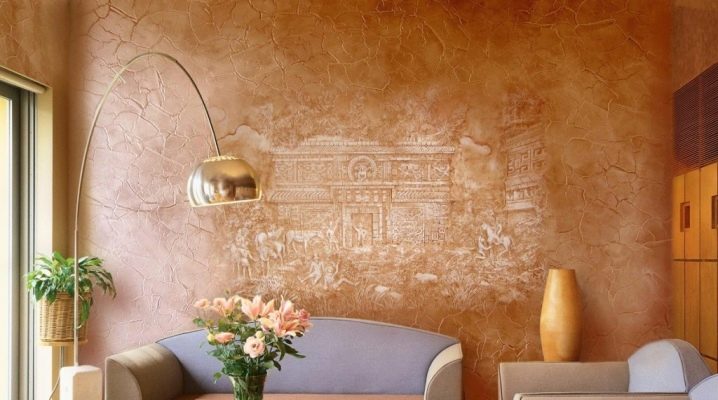
Decorative plaster has firmly taken the leading position among finishing materials. If earlier it was used only to decorate the exterior of dwellings, now it has become popular in interior decoration as well. With its help, surfaces of various textures are created: reliefs, volumetric patterns, velvet, leather, wood, stone. The main disadvantage of this coating is that you need to be able to work with it and you need to have artistic skills.
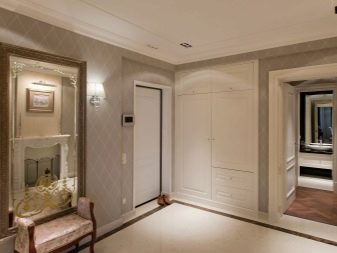
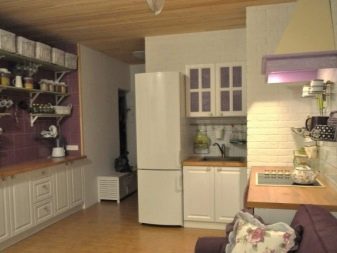
Not everyone can afford to invite a professional, so the building materials market offers an alternative in the form of wallpaper with the effect of decorative plaster.
What it is?
Plaster-stylized coatings are wallpapers that have been printed with a pattern that imitates the textured surface finish. Such imitations, of course, are found on ordinary paper wallpaper, but they look unnatural. For believability, the image must be given volume and relief. Manufacturers achieve this by embossing or spraying.
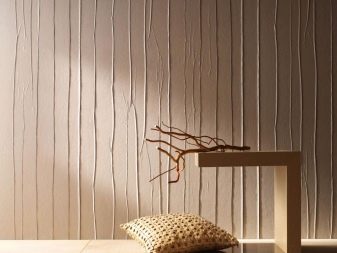

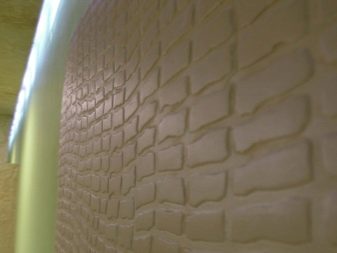
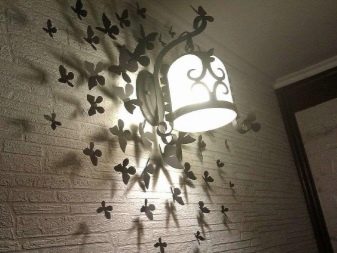
Advantages and disadvantages
It would be wrong to say unequivocally that wallpaper with a plaster effect is the most suitable option for everyone. It all depends on the purpose of the room being decorated, on possible external influences on the coating and on the distinctive characteristics of each material.
- The service of imitators is limited to fifteen years. This is more than that of ordinary wallpaper, but if you decide to make repairs and forget about it for 40 years, then it is better to still choose natural plaster.
- Mechanical damage is almost not terrible for mineral decorative coatings, but the strength of textured wallpaper is also at a height. In addition, they are warm to the touch, so they are more suitable for bedrooms and children's rooms.
- Imitation plaster for walls is perfect if your hobby is frequent interior changes. Wallpaper is easy to change, while plaster is not easy to peel off.
- The cost of purchasing both materials is on average equal. But to work with plaster, you will probably need a master, while you can save money on wallpaper installation by doing everything on your own.
- The practical texture of the wallpaper allows you to hide the joints, and the embossed pattern - possible unevenness of the wall.
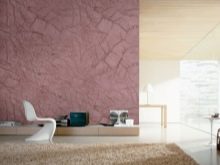
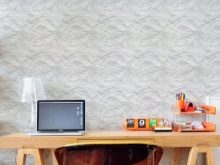
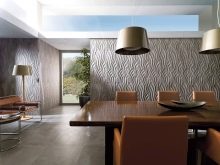
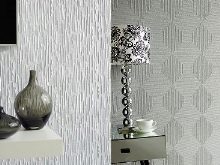
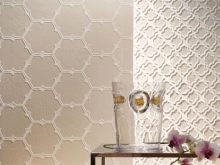
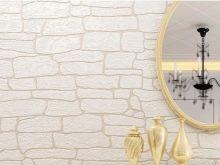
Composition
In terms of their structure, the coatings with the effect of plaster are two-layer. The base can be either paper or non-woven. But the top layer is paper (duplex), polyvinyl chloride (PVC) or acrylic. The embossed structure is applied to vinyl and paper wallpapers. Cloths made using this technology are very durable and practically do not stretch when wetted with glue. The texture of acrylic wallpaper is achieved by spotting the pattern on the base with foamed acrylic.
Varieties
The quality characteristics of embossed wallpaper depend on the materials and manufacturing methods. Manufacturers distinguish between the following types:
Duplex
Duplex is called paper embossed wallpaper. They were named so due to the double paper structure. They are made by wet embossing. Canvases of this type are found with a color image or white for painting. The latter have a more expressive texture, but they can withstand a limited number of stains without deformation.
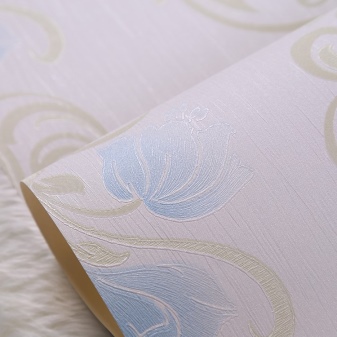
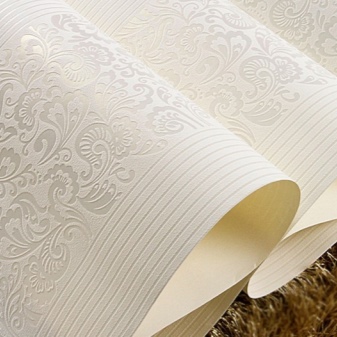
Among the advantages of this type:
- greater strength compared to single-layer paper coatings;
- environmental friendliness;
- breathability;
- low price.
The disadvantages include:
- low service life, on average 5 years;
- the paper is easily damaged mechanically;
- cleaning with water is also harmful to the coating.
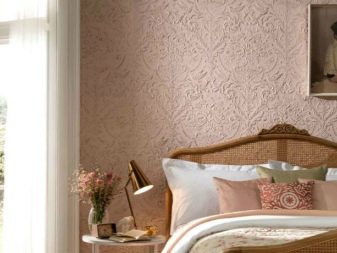
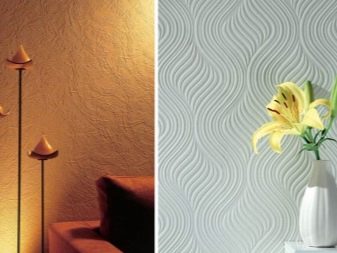
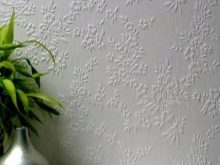
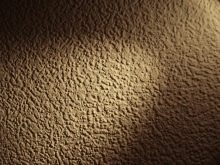
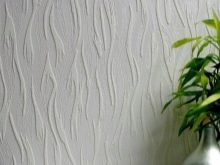
Vinyl wallpapers
The upper decorative layer is PVC, and the base is paper or non-woven. In hot stamping, the base with foamed PVC is heated and passed through embossed rollers. According to this method, three types of wallpaper are created:
- Flat (compact) vinyl - has a high density and strength, resistant to water. Most often, it is on it that the texture of natural stone, tiles, brickwork is reproduced. Wallpaper of this type is a suitable option for the kitchen, especially if they have a non-woven backing. They can be cleaned with or without detergents, and some varieties can even be brushed.
- Heavy vinyl allows you to achieve a universal wall covering: durable, moisture resistant and aesthetic. Plus, perfect wall smoothness is not required. Wallpaper will hide all irregularities and roughness.
- Silkscreen wallpaper created by the method of embossing under pressure paper moistened with vinyl. The output is a thin iridescent material with a smooth silky texture. Such wallpapers are not from the economy class, but they add sophistication and luxury to the interior. The main condition is perfectly smooth walls.
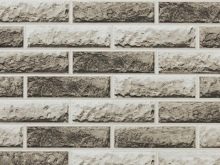
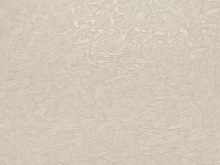
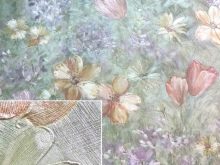
Hot-stamped wallpaper is durable (from 7 to 15 years depending on conditions), UV, moisture, steam and heat resistant. They do not absorb odors and can be damp cleaned even with the use of cleaning agents (non-abrasive). They are also positioned as environmentally friendly coatings, since formaldehyde resins evaporate when heated.
The main disadvantage of this material is low air permeability. Therefore, before gluing, you need to attend to the application of an antifungal primer.

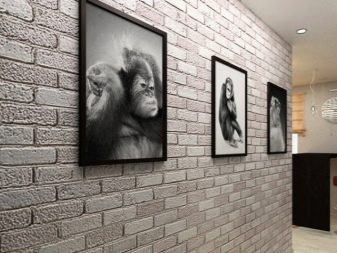
The chemical embossing wallpaper is embossed with a reagent. It is applied to some areas of the PVC layer in accordance with the future pattern. During the heating process, the reagent suppresses vinyl foaming in the treated areas, thereby achieving the desired texture.
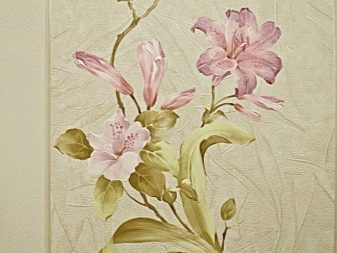

Acrylic Wallpaper
Acrylic wallpaper is considered to be a cheap analogue of vinyl. They consist of a paper or non-woven backing and an acrylic coating. Unlike vinyl, acrylic is applied pointwise, only in places of patterns. Due to this, the breathability of the coating is maintained. At high temperatures, the dots swell, forming a relief pattern.
Acrylic wallpapers are inferior in durability to their vinyl counterparts, since the spraying is vulnerable to mechanical stress and moisture.
Non-woven wallpaper
Non-woven wallpaper is a cover made of several layers of non-woven, a non-woven material made from cellulose fibers. The top layer, as a rule, has a relief pattern. Most often, such wallpapers are made white for painting, but color options are possible. Both options can be repainted up to 10 times without distorting the top decorating layer.
The affinity with paper has made non-woven fabric one of the healthiest materials with good air exchange. Another useful property is that this wallpaper is reusable, that is, it can be easily removed and re-glued in another place.

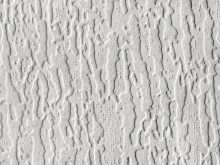
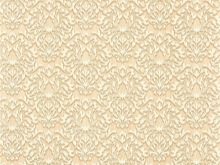
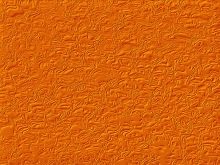
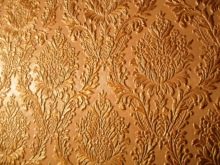

Colors
Wallpaper with decorative plaster effect is available in any color. Therefore, it will not be difficult to find options for your project. The main thing is to remember that the choice of color depends on its influence on the human psyche and the purpose of the room being decorated. So, bright red in the bedroom is unlikely to help you relax, and gloomy brown in the nursery is likely to be depressing. But interiors with one type of wallpaper have long since sunk into oblivion. Companion wallpaper helps to create accents and balance colors. Manufacturers offer ready-made combinations of colors and textures for various interiors and styles.
And for those who prefer to choose combinations on their own, you need to choose samples that are similar in composition and texture, remember about the "color wheel" and about the effect of colors on a person.
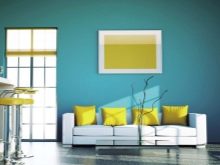
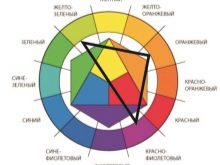
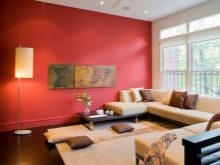
Let's consider several classic combinations:
- Beige wallpaper brings peace and tranquility. That is why they are perfect for a bedroom or living room. A combination with dark shades will add austerity to the room, while whites and other pastel colors will add light.
- Gold wallpaper seems pretentious and flashy. To extinguish excessive pretense, it is enough to dilute them with calm light tones (beige, light brown).
The combination of these colors evokes thoughts of autumn and sets you in a romantic mood.

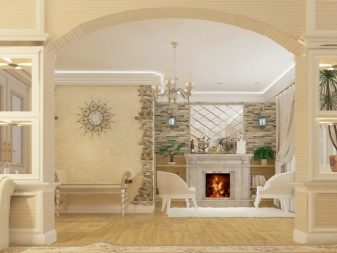

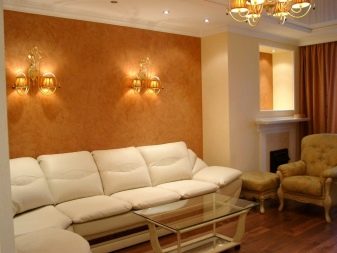
- Brown wallpaper helps to create an expensive and noble, but gloomy style. Most often they are chosen for the design of offices and living rooms. In small rooms, it is better to combine them with light wallpaper and take care of sufficient lighting.
- Orange and reds are vibrant, energetic and exhilarating. They stimulate activity, so they are used with caution for sleeping areas, in combination with neutralizing shades. The best application is living rooms, halls, kitchens.
- Blue wallpaper, on the other hand, reduces activity and soothes. It is worth choosing them for spacious rooms, as they visually reduce the space.
- If the room is small, take a look at the blue wallpaper. Like blue, they relax and calm, but do not affect the optical perception of the room. This color is also recommended to be used in offices with high conflict level.

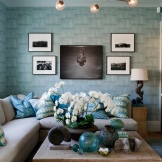
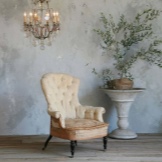
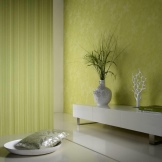
- Green wallpaper - "pushing" the walls. And the color itself symbolizes confidence and life. The effect of green on a person depends on the shade. Light tones relieve tension and put you to sleep, while juicy tones, on the contrary, encourage action.
- It is better not to use black and white wallpaper alone in the interior of the apartment. The excess of black is depressing, and completely white walls are associated with the sterility of hospitals. Both options go well with other colors and with each other.
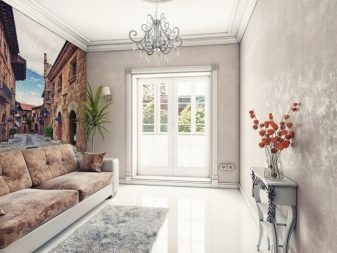
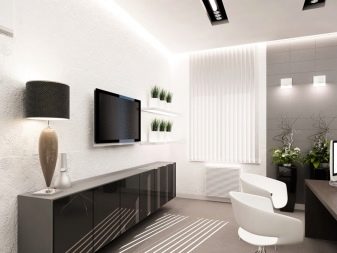
Styles
Designers use plaster-patterned coatings to create any style - from classic to high-tech. Thus, embossed wallpaper with the effect of an aged surface harmoniously fits into both classical and ethnic styles.
Natural motives (waves, clouds, vegetation) are found in almost all directions. But the mysterious shine of metal is ideal for high-tech interiors.
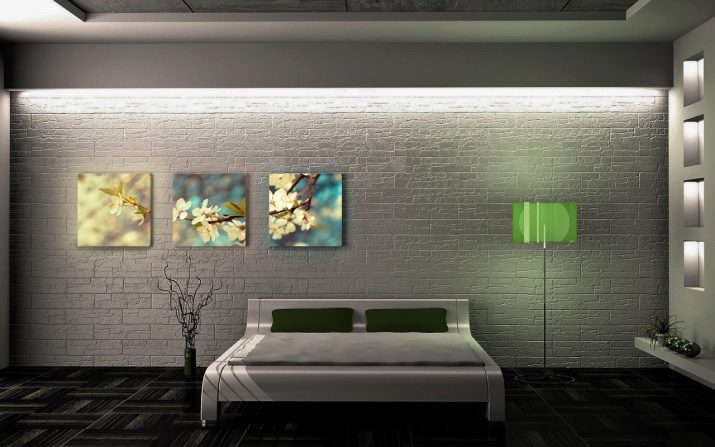
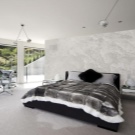
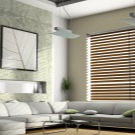
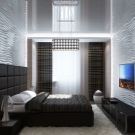
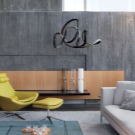
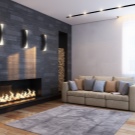
Imitations of a concrete wall look unusual. Such a coating does not have a clear relief, but has a rough surface and a characteristic texture. The concrete effect is most characteristic of the industrial loft style.
Marble wallpaper imitating Venetian plaster will appeal to fans of Italy. Venetian plaster combines naturalness and carelessness - qualities that distinguish Italian traditions in interior design. However, marble-like coatings are not limited to the Italian style, they can be the foundation of any interior.
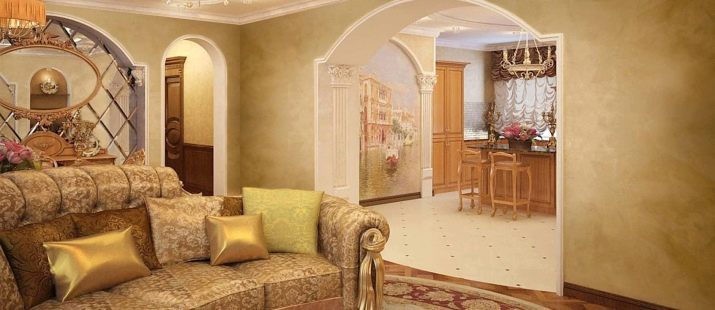
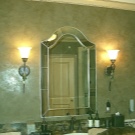
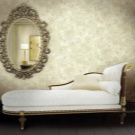

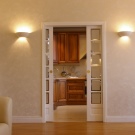
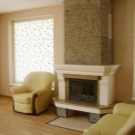
Where to paste?
Embossed wallpaper is a universal material that will complement the design of a room for any purpose. Particular attention should be paid to the living room as the face of your home. This is a place for receiving guests, communicating, so bright, eye-catching decoration elements are permissible here. If the accents in the design are called upon to place unusual furniture or intricate art objects, then the wallpaper, on the contrary, should be restrained, neutral tones.
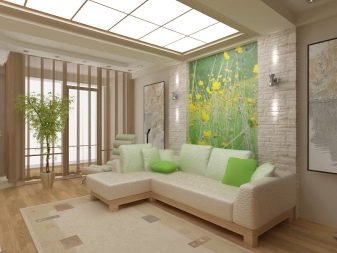
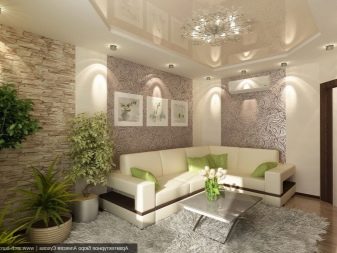
For a bedroom, it is better to refrain from bright and intrusive textures, or use them in areas that are not in sight during rest. The most suitable place is the bedside area. The wall behind the headboard is often the centerpiece of a bedroom.

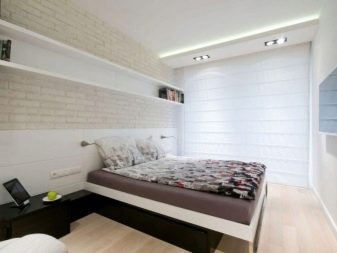
It is better to choose textured wallpaper for the kitchen on a non-woven base. Super washable samples are even used as an apron in the work area.
How to choose?
In order not to be mistaken with the choice of wall finishing material, it is important to take into account several points:
- The visual effects of embossed wallpaper affect the perception of the size and geometry of a room. For example, a large drawing or dark shades reduce the space;
- despite the wear resistance of textured coatings, you should not use them on walls with constant mechanical stress;
- of all types of wallpaper, non-woven are the more practical and versatile;
- it is important to remember the purpose of the room when choosing the texture and color of the cladding;
- be sure to look at the composition of the wallpaper. Canvases of different characteristics may look the same outwardly.
Beautiful ideas in the interior
Plaster-like coatings are great for zoning rooms. For example, the combination of bright and restrained shades and textures in the bedroom allows you to focus on the sleeping area.
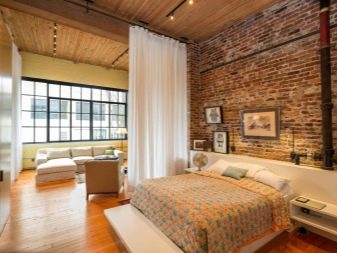
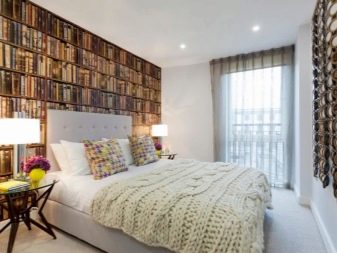
The living room often combines a place of rest, reception, work. Therefore, the competent use of textures helps to delimit the space for the needs of each family member. This is especially true for studio apartments.
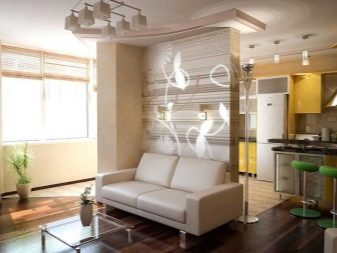

Textured wallpaper in the interior can be viewed in the following video.













The comment was sent successfully.